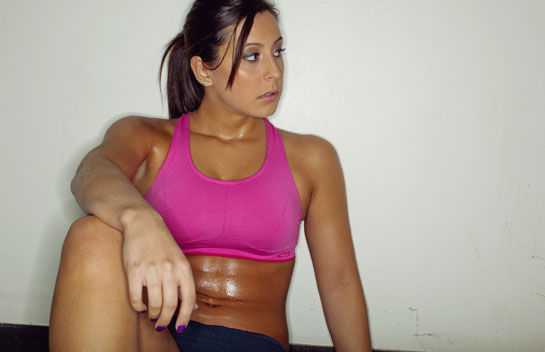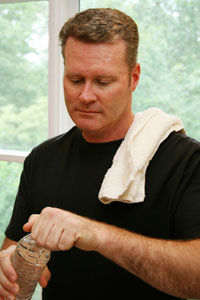
By CEDRIC X. BRYANT, Ph.D., ACE Chief Science Officer
Q: What’s the best way to get acclimated to hot yoga classes and avoid a heat-related injury?
A: With hot yoga classes continuing to hold their popularity, it is important to understand how the body cools itself when heat stress is present and what countermeasures to take to minimize the risk of heat illness. The body attempts to maintain a stable core temperature by balancing the rate of internal heat production with heat loss to the environment. This delicate balancing act is known as thermoregulation. Thermoregulation, however, can be very challenging in a heated environment, especially if the air temperature is greater than the skin temperature. In a hot yoga class, the room in which the activity is conducted is typically heated to 90–110º F (33–43º C), which not only exceeds normal skin temperature, it may be greater than the core temperature in an exercising person. If there are no fans in the room, three of the four ways the body releases heat (radiation, conduction and convection) are not viable options, which forces the body to rely on evaporation to dissipate the heat generated by exercise. In addition, when the room is warmer than the body, the exerciser’s body will actually gain heat from the environment, further increasing the individual’s core temperature.
Evaporation is the body’s primary protective measure against overheating. Through this process, the body transfers heat from its core by evaporating sweat from the skin and respiratory passages. Sweating alone, however, does not cool the body. To produce a cooling effect, the sweat must be evaporated to lower the skin temperature. When cooler air is blown over the skin, sweat vaporizes and heat is released. It is important to note that evaporation can be impaired by the humidity level in the exercise area, which will then increase the rate of sweating of the participants. This situation can result in an even greater loss of body water, which, in turn, can lead to dehydration. In a hot yoga class, the humidity level may be high, depending on the amount of ventilation in the room and the number of students participating in the class. The humidity level will increase if the room is poorly ventilated and is packed with exercising and heavily sweating participants. An additional consideration is the practice of wiping sweat from the body using a towel. If the sweat is removed from the skin, less evaporative cooling will occur, and body heat will be retained. As a result, the amount of sweating will subsequently increase, leading to a greater loss of body water and an increased risk of dehydration.
As the sweat rate increases, the amount of body water lost also increases, and the need to consume replacement fluids becomes vital. Without adequate fluid replacement during exercise, the body’s ability to dissipate heat is greatly compromised. Achieving and maintaining proper hydration status prior to exercise is essential to avoiding dehydration. If a person is properly hydrated at the start of an exercise bout, the effectiveness of fluid replacement during exercise is significantly enhanced. As dehydration occurs, the body experiences a decrease in the plasma volume of the blood. As plasma volume decreases, the body’s ability to lose heat is diminished. As such, a reduction of as little as 2 percent in body weight during exercise can result in impaired temperature regulation. Furthermore, a 4-percent decrease in body weight translates into a 6-percent decrease in maximal aerobic capacity and a 12-percent reduction in exercise time to exhaustion.

Adequate hydration is clearly a critical factor in preventing the adverse effects associated with exercising when the temperature and/or humidity are high inside the yoga studio. In this situation, the ideal approach is to take appropriate steps to prevent dehydration during the workout. To achieve this objective, participants should be encouraged to undertake the following steps to ensure that they are well hydrated before participating in a hot yoga class:
- Consume fluids at regular intervals throughout the course of normal daily activities.
- Drink 17–20 ounces of water or a decaffeinated beverage at least two hours prior to the class.
- Drink frequently and early, before the onset of thirst during exercise. The underlying goal is to match one’s sweat loss with fluid replacement. This is especially important for middle-aged and older (>50) participants who, as a group, tend to have less-sensitive thirst mechanisms.
- Measure body weight prior to exercise, and evaluate any change in body weight after class. Consume fluids to return body weight to normal. Drink 16–24 ounces of fluid for every pound of body weight lost during exercise.
- Make sure replacement fluids are cold and palatable.
Since the environment in a hot yoga class tends to substantially increase the amount of body fluid lost, strict adherence to the aforementioned hydration guidelines is critical.
Another highly recommended method for decreasing the risk of developing heat illness or injury is to gradually acclimate to exercising in hot environments, such as a hot yoga class. Through acclimation, heart rate and body temperature (at a given intensity) decrease, sweating rate increases, and sweat becomes more dilute. It has been estimated that as many as one in four healthy adults may be heat intolerant in an unacclimated state, with that number decreasing to approximately one in 50 after acclimation. The best method of heat acclimation is to start exercising aerobically in a hotter-than-normal environment, gradually increasing the length of the exercise session over time. For safety reasons, the first session should be limited to 10 to 15 minutes and gradually increased to 20 to 60+ minutes as the exerciser acclimates to the heat. As a rule, it takes most healthy people 10 to 14 days to fully acclimate to hot environments, a schedule that illness and alcohol consumption have been shown to slow down.
It should also be noted that the benefits of heat acclimation are lost quite rapidly when an individual stops exercising in the heat. For every two days of abstaining from exposure to the heat, one day of acclimation is lost. Thus, after three to four weeks, an individual should be considered unacclimated. Consequently, after even relatively brief periods of deacclimation (weekends, short periods of illness), the risk of exercising in the heat can be substantial.
Understanding and applying the principles of thermoregulation, particularly the maintenance of proper hydration and the process of acclimation, will enable individuals to decrease their risk for sustaining a heat illness or injury while participating in a hot yoga class or exercising in any kind of heat-stressful environment, for that matter. Given the potential dangers associated with a heat illness or injury, such an effort is very wise and well justified.
___________________________________________________________________

Cedric X. Bryant, Ph.D., FACSM, represents ACE as Chief Science Officer and a national and international lecturer, writer and expert source. Bryant has written more than 200 articles or columns in fitness trade magazines, as well as sports medicine and exercise science journals, and authored, co-authored or edited 30 books.